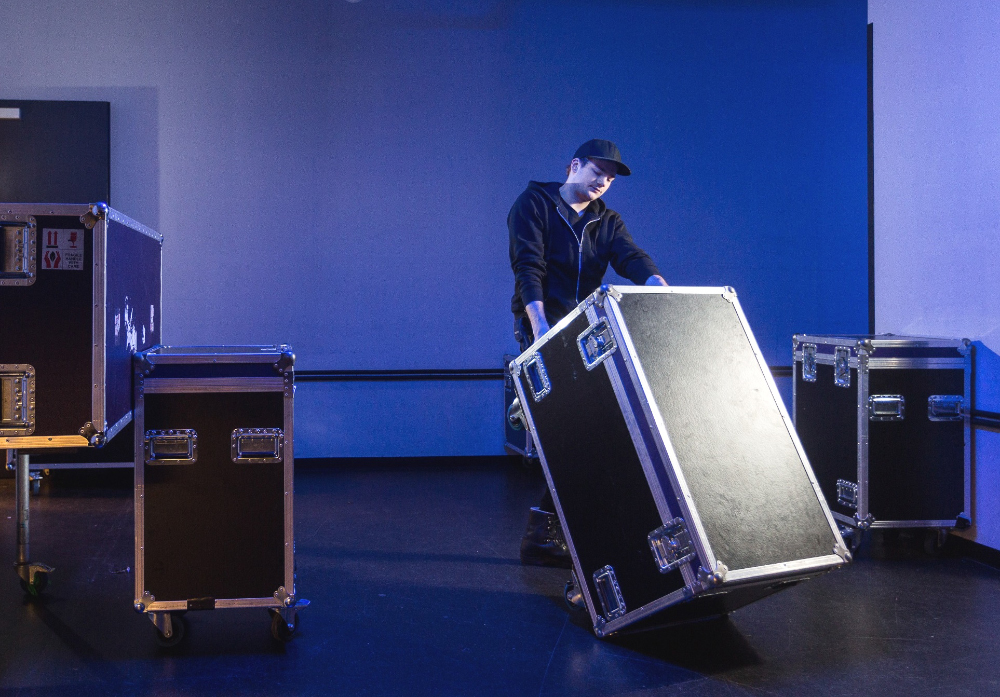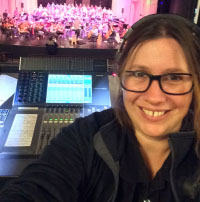Ah, road cases, workhorses of the AV production world. They protect our mission critical gear from being rattled apart on rough roads, outdoor conditions like dusty winds and rain, and the thousand natural shocks that gear is heir to. They also make good chairs and tables, and can be an excellent place for a nap.
This style of transport case has become a symbol of production crews. They’re not glamorous, but they get the job done reliably while staying out of sight. One might assume that road cases are one more example of repurposed technology from another industry, but they truly are all our own – developed and built right alongside the first large-scale PA systems of the 1960s and 70s.
I recently sat down with a few early pioneers to talk about the “why’s and how’s” of boxes on wheels, and this is what I found out.
Early Origins
After World War II, traveling musicians were carrying more sensitive electronics than ever. Electric guitars and amplifiers, synthesizers, and entire Hammond Organs were being transported regularly down dirt roads and railways. They were also in constant need of repair from the rough conditions.
In 1952, Chuck Vallas established Anvil Cases in California to offer a new option: transport cases for the traveling troubadour. The cases were initially made from fiber- or Tolex-covered birch plywood with plastic edge covers, with latches and casters ordered from manufacturers such as JH Sessions and Son. The success of Anvil’s instrument cases led to production companies commissioning something altogether more rugged two decades later.
By the early 1970s, major concert audio companies were moving entire trucks of extremely large and heavy gear across an unfinished interstate system night after night, and re-soldering connections every morning. There were no mass-produced large-format PAs at the time, so there also wasn’t any standard packaging. To keep the equipment organized and undamaged during transport required building something just as custom as the gear itself.

For the uninitiated, Showco was a large-scale concert sound company based in Dallas that was acquired by Clair Global in 2000, and according to former Showco employee and founder of Crossroads Audio, Chuck Conrad, “Rusty Brutsche, one of Showco’s owners, was a mechanical engineer and was very keen on making everything ‘road ready’ and able to survive being pounded around in a truck. They actually built their equipment to fit perfectly in the trucks of the time. It was also very over-built, compared with what you could buy. A lot of design decisions were based on truck pack size.”
Indeed, the size of the cases was determined by measuring the space in the box trucks still widely used today. The width of the trucks was divided by 4, then 3, then 2, and then 1/4 of an inch was subtracted to allow room for a strap. This is where the 22 x 30-inch and 22 x 45-inch standard dimensions originated. These cases can be loaded in rows of 4, 3, or 2 – depending on how you’re playing Tetris.
Cost was another major concern. Specifically, the cost of shipping cases from Anvil in California to Showco in Dallas, or to Clair Brothers and Maryland Sound International even farther East, meant all three companies saw the benefits in building their own “black boxes.”
Conrad goes on to say, “I remember [Showco] got our first Anvil cases by going to the factory and picking them up [because] we were doing shows in the area…If we’d had them shipped, it would have greatly increased the cost. When [Crossroads] started building cases it was very much about money. We had a woodshop where we built a lot of speakers, so adding cases was almost a no-brainer.”
In 1975, drummer turned entrepreneur Joe Calzone closed that distance for East Coast musicians and production companies when he started Calzone Case Company, today the largest manufacturer of fabricated cases in the world according to its website. “I was in Connecticut, much closer to New York than Anvil. Sessions and Son [sic] was right there, too, so it didn’t cost as much in shipping to get parts from them,” Calzone notes.

Shops road tested materials until they each settled on what worked for their gear. Almost everyone chose 1/2 or 3/4-inch birch plywood with a top layer of ABS or fiberglass. Maryland Sound International built its cases out of steel with fiberglass inserts, earning them the nickname “Sound by the Pound,” according to founder Bob Goldstein. Aluminum edge covers with steel ball corners proved more popular over time across the industry, due to the difference in both weight and cost.
After seeing how his cases fared on their first tour, Calzone also went back to the drawing board and upgraded the plywood, going from 3-inch casters only rated at 250 pounds to 6-inch models rated at 1,200 pounds. By the time Calzone Case contracted with UK-based sound company Brittania Row in 1979, the new case designs had proven truly roadworthy.
Coming Into Focus
Due to the amount of fabrication happening in the shops of that era, building a few cable trunks with the tools on hand was a perfect project for downtime and a good way to keep costs down. Rack cases, on the other hand, require more tools, hardware, and space to construct.
With outboard gear already following standard rack unit sizing, companies could begin ordering standard sized cases from manufacturers with the dedicated tools and space to make them. Road case manufacturers could sell cases to several production companies at a time. In turn, the major production companies all ordered cases from Anvil, Calzone, and LM Cases (based in Ohio) at different times over the years.

No matter who built it, they would order the hardware from yet a different manufacturer. While JH Sessions and Son was a popular choice, other companies such as Adam Hall (established in 1975 in England) were also making latches, hinges, handles, and casters specifically to serve the needs of this new live event industry. Richard Stratford of hardware manufacturer Penn Elcom explains, “The machinery and tooling required to produce the case hardware is far different from the machinery used to build road cases.”
By the mid-1980s, many more concert production companies, clubs, churches, and self-contained touring bands had entered the market. More road cases were needed, and that demand was met with an ever increasing number of case manufacturers. One of those companies was LM Cases, known for their attention to detail and high-profile clients. I asked the owner, Bill Laguardia, what was driving growth when he and former business partner Joe Maluso started making cases together.
“We realized quickly that electronics were ever-evolving and the demand for better and less expensive products meant short product life cycles,” Laguardia says. “Thus rental companies would turn their inventory every 12 to 24 months to provide the newest and the best… and that all needed cases. I suspect the short product life cycles of this wonderful tech had a lot to do with the influx of case and production companies in the 80s.”
The symbiotic relationship between the people who need rolling boxes and the people who make them continued as the client base diversified to include corporations, schools, and governments. Today, most cases manufacturers also make state-of-the-art cases for medical and military applications, among others.

Production companies and road case manufacturers are still finding ways to improve. Clair Global and MSI both continue to build many of their own cases today. Lighter, sturdier materials are being introduced regularly and new, innovative designs are constantly being drawn up. CNC wood cutting, sophisticated CADD programs, and other leaps in technology have been adopted to improve cost and manufacturing speed.
But make no mistake, these companies were forged in the fires of live music touring. When speaking to each of these individuals, there’s no question that their love of music is what drives them – the boxes are just what get them there. From the humble, homemade cable trunks of the 70s to the tricked-out work boxes of today, road cases are at the beating heart of the industry that created them, just as reliable and invisible as the roadies themselves.
Author’s Note: my heartfelt gratitude to Chuck Conrad, Joe Calzone, Bill and Billy LaGuardia, Richard Stratford, Bob Goldstien and Keith Price at MSI, and Claire Messimer of Clair Global for being so generous with their time. And to one of the earliest box builders, Robin Magruder, who ingrained in me, “If it isn’t on wheels, then put wheels on it.”















